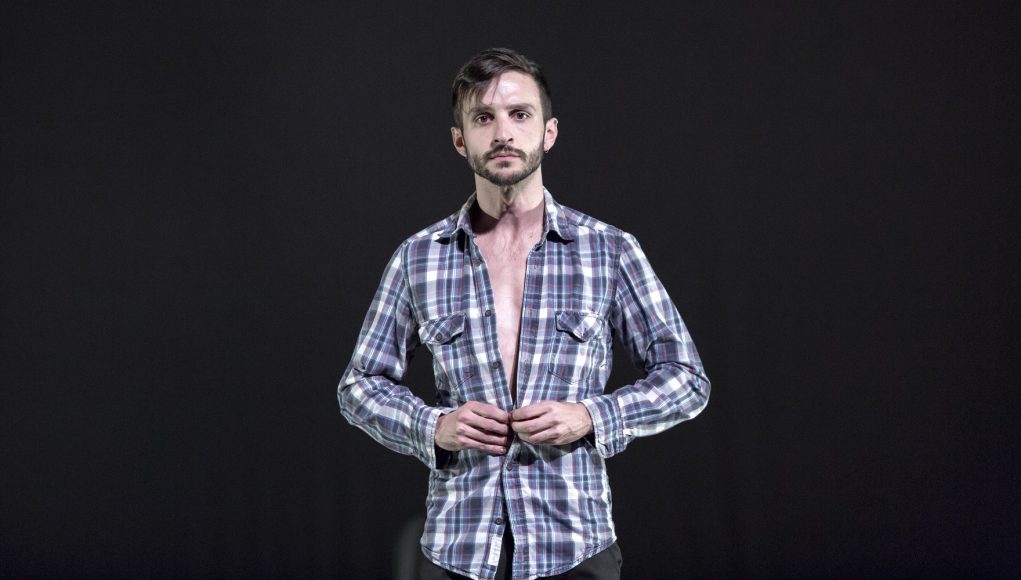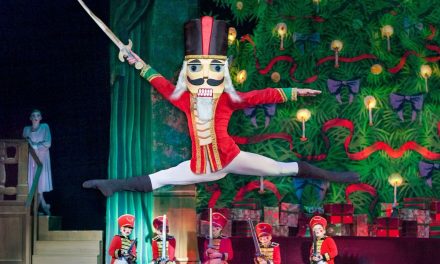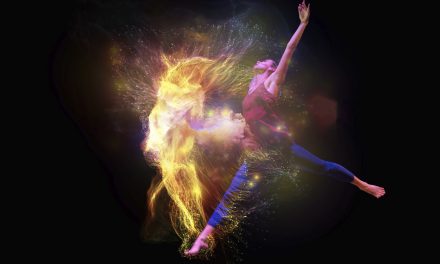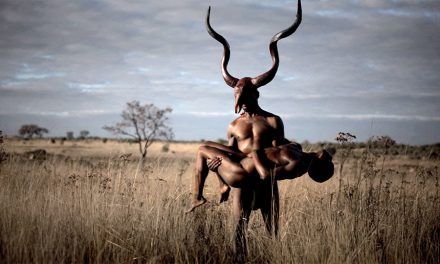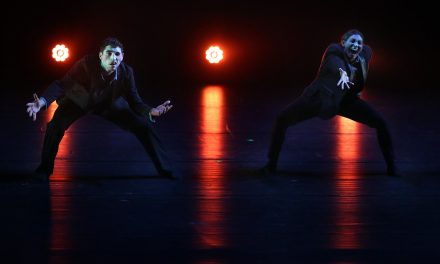Andrew Pearson is one of L.A.’s finest dance artists. His earliest journeys into performing occurred at the early age of 4, creating playful performances for his parents and their friends in Pleasanton, CA. At age 11 he began taking hip hop classes and then ballet classes at age 14. After high school, Pearson earned his BFA in Dance at UC Irvine. Following graduation, he performed with Headwaters with whom he had the opportunity to work with notable dance artists John Jasperse and Donna Uchizono. After a brief time working with BODYTRAFFIC, Pearson joined the Los Angeles Contemporary Dance Company (LACDC) in 2011 for which he choreographed a new work in 2013. In the fall of 2014 Pearson took a short time off from LACDC to study in Europe. In late 2016, he launched the Contemporary Dance Practice: LA. He is a very talented and busy artist performing with LACDC, creating solo works and free-lancing as a teacher and guest artist.
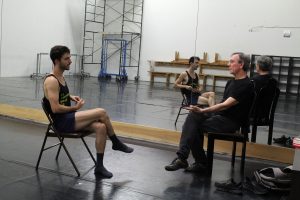
Andrew Pearson, Jeff Slayton during interview – Photo: Roger Martin Holman
Pearson agreed to meet for the interview at Brockus Project Studios in L.A. We talked during a rehearsal break for his upcoming premiere of this is a blank page. a story, in motion opening at Highways Performance Space on August 4th. He is the director and performer in this three section dance-theater piece which features an original score by Evan Monheit.
Pearson performed early versions of two of the sections on the first Dance Back series, and the Los Angeles Dance Festival, both produced by Deborah Brockus, and as part of the Orange County Dance Festival. I was interested to know about his process for incorporating the solos into a full evening, and why now.
“I always had an interest in creating long form work. When I made them (the first two solos), I had no idea of making an evening work. I had an idea that they were connected.” Pearson said. “I felt that the same themes keep coming up while I was working, so I felt that it was definitely clear that I have more to say than just 15 minutes.”
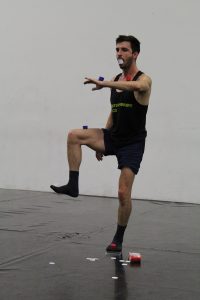
Andrew Pearson for the interview- Photo: Roger Martin Holman
Pearson has had a connection to Highways for several years. About a year ago he hinted to the directors, “I think I have a show. I really don’t know, but I’ll let you know.” Realizing that having a deadline helped, when Deborah Brockus approached him in 2015 about performing on her first Dance Back series at Diavolo Performance Space, he immediately said yes. That solo was next performed on the 2016 New Shoes series at Highways, in San Francisco, and on a faculty concert in Kentucky where he was the guest artist. A second solo was created in 2016, and in 2017, Pearson created a third solo to complete the over-all arc of the show. It has taken two years to get this is a blank page. a story, in motion to the point it is now.
Inspired, in part, from pages of his journals, these solos are thoughtful and introspective. I asked Pearson if the earlier performances lead to specific changes in both content and context of the finished product.
“Yes, of course.” He said.” Because I am both the choreographer and the performer, there are a lot of things that I gain by having eyes on it. I video rehearsals, but that just isn’t the same. I’ve also been very fortunate to have lots of friends interested in attending rehearsals and providing feedback. That has definitely shaped and formed how it all happens.”
While choreographing the first solo, he had a sense that it was a humorous dance. It wasn’t until the audience laughed, however, that he knew for certain. He explained that the audience’s reaction altered and shaped how he now approaches the movement. When asked if he found himself playing for laughs, he smiled and answered, “I try not to!”
The first solo is performed to a collection of covered pop songs, and the final section to Monheit’s original score. Pearson asked Monheit, who works primarily in film, what it would cost for him to compose a score. Monheit replied that he had been wanting to write music for dance and surprised Pearson by saying “I have this orchestra (FAMES Macedonia Orchestra), so it’s a gift.”
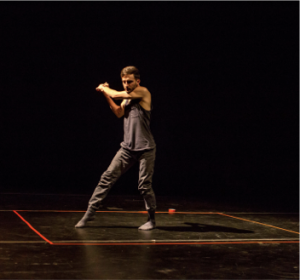
Andrew Pearson in performance – Photo by Cheryl Mann
Pearson sent Monheit video clips of his solo and at first the composer attempted writing for specific movement phrases. Pearson encouraged him to shift his process. “I want you to be inspired by what you see and then compose the music. I will then respond to how you responded.”
Pearson explained how “It became this wonderful back and forth between the two of us, and he’s taken my performance of the piece to places that I never would have anticipated, but that was so on mark for what I was doing. I think that’s the nature of how the collaboration developed,” Pearson continued. “and there were places that I knew that I could not ignore a specific sound; or, I had to really ignore it.”
Pearson is a very musical dancer and I enjoyed watching him work with and against the composer’s phrasing and quality shifts. He does not simply visualize Monheit’s music, but skillfully moves in and around it; always staying true to his artistic vision.
Pearson’s movement exploration for this solo was very specific. While dealing with the feeling of not having enough time and money, he relied on his resilience and resourcefulness as an artist to work in the confines of his kitchen for six months. I remember seeing brief video clips of this on his Facebook page.
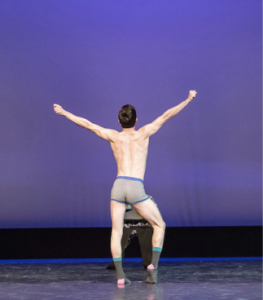
Andrew Pearson – Photo courtesy of the artist
Pearson enjoys the collaborative options offered at Highways. In the past, he curated one of their festivals, performed his work on New Shoes and danced there in works by other choreographers. He finds it a great space for artists to present their work, and a safe, friendly atmosphere in which to try out new ideas. As a gay man, he is also aware of the huge support that Highways has provided to LGBTQ artists for more than 20 years.
I asked Pearson why he chose this time to present an evening of his own work.
“I am turning 30 and I’ve been asking myself ‘am I doing this ‘thing’ right?’” After a thoughtful pause, he continued. “I started working on the piece when I got back from a trip to Europe. I took classes and saw a lot of work, and I was so preoccupied before on making work correctly; making work in the way that you’re supposed to. I was so focused on trying to get commissions without really having a voice or a body of work to show for myself.”
When Pearson got back he did not know specifically what he wanted to make, but he knew that he had to get into the studio consistently to begin exploring movement ideas. This led to the first solo. Audiences responded positively and so he kept going. When he told me that he was turning 30, I suggested that this show was a birthday present to himself. He graciously smiled and said, “Yes, perhaps.”
this is a blank page. a story, in motion is a dance-theater work inspired by such questions as “how would one create a self-portrait in dance?” Pearson explores themes surrounding partnership, sexuality, identity, comfort zones, and scarcity vs. abundance. He strings together tales from his childhood with musical vignettes and social commentary, and he examines how humans aspire to expand their arenas of comfort while simultaneously seeking fulfillment inside their present situation.
this is a blank page. a story, in motion will be presented at Highway Performance Space in Santa Monica on August 4 and 5 at 8:30PM. For more information and tickets, click here.

